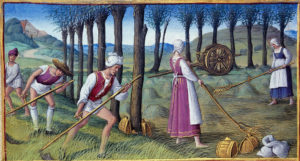Painters still make oil paintings just as they did during the Renaissance, and sculptors still carve figures out of stone, but who today makes illuminated manuscripts? What artist today would put all the richness and detail of an oil painting onto small vellum leaves, and then fill a book with them – all for one client? It’s a lost art.
You don’t even see illuminated manuscripts that often in museums. The books are fragile, light-sensitive, and – unless the book is broken up – can only be exhibited one page at a time.
But these books are amazing artistic accomplishments. They magically combine monumental subjects – the life of Jesus, the martyrdom of saints, the slaying of dragons, the raising of the dead, and eye-stretching landscapes – with the intimate experience of peering into a book.

“Mowing” by Jean Poyet from “The Hours of Henry VIII.”
The best of these artists belong right up there with Michelangelo and Leonardo, but who can name one? They worked in a tradition in which the name of the patron was more important than the name of the artist. The “Tres Riches Heures of Jean, Duke of Berry,” from the early 1400s, is called one of the miracles of art history, but the artists, the Limbourg Brothers, are practically a footnote.
In many cases, the artist’s name doesn’t even appear in the book, and art historians have to make attributions based on documents or stylistic indications.
One artist whose career has been pieced together this way is Jean Poyet (1445-1503), who worked in Tours, France, and is the subject of an excellent show at the Morgan Library. Curated by the Morgan’s Roger S. Wieck, this exhibit does a good job of explaining the illuminated manuscript tradition and puts Poyet’s work in the context of his predecessors, his contemporaries, and his competitors.
The exhibit design gets around the one-page-at-a-time problem with actual-size transparencies mounted on lightboxes that give a vivid sense of the manuscripts’ brilliant colors. And, a CD-ROM room gives viewers a sense, onscreen, of what a book is like in its entirety, allowing them to turn the virtual pages.
The Morgan owns the world’s biggest collection of Poyet manuscripts, including “The Hours of Henry VIII,” and the superb Prayer Book of Anne de Bretagne, a manuscript that the French queen commissioned to teach her son, the dauphin, Charles-Orland, his catechism.
Poyet, like other illuminators from this time, worked almost exclusively on one type of manuscript, the Book of Hours. These prayer books, made for laypersons, contained a sequence of prayers to the Virgin Mary – the object of cultish devotion during the Renaissance – that were, ideally, recited throughout the day, hour by hour. In addition to the religious illustrations, the books served as calendars, family records, and primers for children.
The hugely popular mechanically printed versions with woodblock illustrations were the world’s first mass-market publishing phenomenon. Between 1480 and 1610, 1,775 different editions of the Book of Hours were published. Every Christian household in Europe had to have one, and, for many it was the only book they owned.
However, as printers competed to come up with better-looking books for the masses, a commensurate demand grew among the aristocracy for exquisite, handmade books to demonstrate their social superiority.
These luxurious books, produced in workshops like Poyet’s, were done in rich colors embellished with gold, and had elaborate borders with floral, animal, and pictorial motifs.
Poyet was one of the best illuminators of his time, and he worked for three successive French kings, Louis XI, Charles VIII, and Louis XII. Celebrated in his lifetime and admired for a few generations after, Poyet was compared with such giants of Renaissance art as the Flemish painter Rogier van der Weyden. Then he faded from view. At one point, scholars attributed much of his work to his contemporary rival, Jean Bourdichon.
His reputation has only been revived in the past 20 years. But, the problem of attribution never quite goes away. The only documented work of art linked directly to the name Poyet is a single leaf that apparently survived from a small Book of Hours commissioned by Anne de Bretagne, Queen of France under both Charles VIII and Louis XII. A 1497 payment slip she made out to Poyet covers the entire book, which consisted of 23 miniatures, 271 borders, and 1,500 line endings, small decorations that fill out short lines in the text.
One of Poyet’s great accomplishments was to bring the illuminated manuscript – a medieval medium – into the full light of the Renaissance. Visits to Italy exposed him to the works of Mantegna and Bellini, and he absorbed lessons in perspective, color, light, and the lifelike rendering of the human figure. Suddenly, in those cramped spaces of the Gothic manuscripts, there was a sense of real space and real people.
You can see it in the double-page illustration “Road to Calvary” and “The Crucifixion,” from one of his late manuscripts. Poyet has orchestrated the space beautifully, showing Jesus in the center, his hands roped. Soldiers and spectators, including the stricken Virgin, climb the hill as preparations are made at the top for the Crucifixion.
From “The Hours of Henry VIII” are startling images of saintly martyrdom and miracles. In one, St. Catherine is rescued from death between two giant spiked wheels. The painting captures the moment that an angel caused the wheels to explode into shards, slaying her tormentors. In another, St. Martha is shown subduing a dragon that had been terrorizing the populace. We see her leading the beast out of its cave by a rope, the legs of its latest victim still protruding from its mouth.
Morgan Library, NYC
2001

